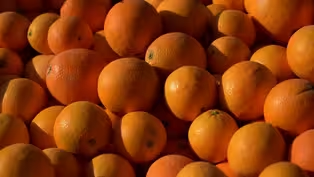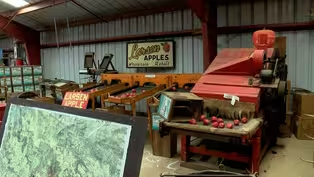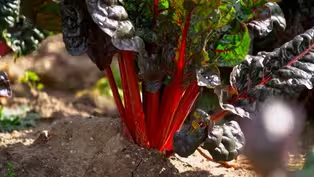
Spanakopita – Farm to Fork with Sharon Profis
Clip: 6/30/2023 | 5m 37sVideo has Closed Captions
We’ll show you how to make a popular Greek recipe, Spanakopita with Tzatziki sauce.
We’ll show you how to make a popular Greek recipe, Spanakopita with Tzatziki sauce.
Problems playing video? | Closed Captioning Feedback
Problems playing video? | Closed Captioning Feedback
America's Heartland is presented by your local public television station.
Funding for America’s Heartland is provided by US Soy, Sustainable Agriculture Research and Education, Rural Development Partners, and a Specialty Crop Grant from the California Department of Food and Agriculture.

Spanakopita – Farm to Fork with Sharon Profis
Clip: 6/30/2023 | 5m 37sVideo has Closed Captions
We’ll show you how to make a popular Greek recipe, Spanakopita with Tzatziki sauce.
Problems playing video? | Closed Captioning Feedback
How to Watch America's Heartland
America's Heartland is available to stream on pbs.org and the free PBS App, available on iPhone, Apple TV, Android TV, Android smartphones, Amazon Fire TV, Amazon Fire Tablet, Roku, Samsung Smart TV, and Vizio.
Providing Support for PBS.org
Learn Moreabout PBS online sponsorship♪♪ [Sharon Profis] Today, we're making a Greek dish called Spanakopita, and the star ingredient is spinach.
So, I have a pretty deep pot here.
A couple tablespoons of olive oil.
To start off the base of our filling is shallot and garlic.
And we'll sauté this until the shallots are translucent and the garlic is fragrant.
A little bit of salt.
All right, now it's time to add our spinach.
What we're doing here is wilting the spinach and, uh, cooking it down a little bit and actually getting out some of that moisture content.
And I'll start by adding about a quarter of it, let that wilt, add another quarter, and so on until we've gotten through the whole bowl.
Our spinach is ready, so let's head back and strain it.
Let's make the filling for our Spanakopita.
We have the spinach that we cooked right here.
There's also a lot of water still in these leaves, so we want to strain that out.
I'm just taking a spatula and going to town on this spinach.
We want to get all of that water out.
If we have a soggy filling, we won't have a crispy outer shell on that pastry.
You can see the spinach is a lot drier, so let's go ahead and dump this water and continue making our filling.
For the rest of the filling, we will need two tablespoons of toasted pine nuts.
We'll add to that two tablespoons of raisins.
I also have two ounces of freshly grated parmesan cheese.
That'll add a little bit of salt.
We'll do the zest of one lemon.
I have my zester here.
We have fresh oregano and fresh dill, just a nice rough chop here.
All of this dill and oregano go right in, and we'll add two eggs to this filling and we'll get these all mixed up.
And I saved the most important ingredient for last, which is our feta cheese.
This way, you get nice chunks of the feta cheese as you enjoy this dish.
And what I'll do is just break off about half inch pieces, and now I'm just gently folding it in.
I don't want to break it up too much.
And that is our filling.
So, let's set up to assemble our pastries.
To assemble the Spanakopita, we'll need phyllo dough.
And because it's so thin, what we want to do is create layers.
And the way we do that is by putting a little bit of butter between each layer of pastry, and don't worry about completely covering the pastry with butter.
So, that's one layer.
We'll do two, and then we'll add one more so that we have three layers of the phyllo.
And from here, what we want to do is portion out each pastry.
So, each one of these three-layered sheets is going to give us four pastries.
And to do that, we'll just find our fourths here.
You want, oh, maybe a quarter cup of filling in each.
And now, here's the fun part.
We'll make our triangles.
Go over like that, once more, keeping all of the filling tucked in.
And I'll just keep going.
Let's repeat the same process for the rest of these, and then we'll do another three layers of phyllo.
And the final step here is to add a little more butter to the top of each of these triangles.
And then, to that, we'll sprinkle sesame seeds.
And we're set.
I'll put this in the oven at 375 degrees, and I'll start checking on it at about 20 minutes.
We're looking for a nice golden-brown crust.
And at that point, the filling should be fully cooked through.
After about 25 minutes in the oven, the Spanakopita is ready and it is just a beautiful golden-brown color.
And let's take a little peek inside.
You can see our spinach and feta filling is just beautiful.
We got a nice big chunk of feta.
That's exactly what we want to see in this dish.
And one of the ways I love to serve it is with a side of tzatziki sauce.
Here's how you make it.
For this recipe, you'll need one cup of whole fat Greek yogurt, one grated cucumber, two tablespoons of fresh dill, two tablespoons of mint, salt, pepper, olive oil, and the juice of half a lemon.
Start by using a tea towel or your hands to squeeze out as much of the water from the cucumber as you can.
Combine the cucumber with the remaining ingredients, give it a mix and chill the tzatziki in the fridge for at least an hour before serving.
After the sauce has set and the spanakopita has cooled, I just like dolloping a nice amount right on top.
And now, all that's left to do is eat!
♪♪
Video has Closed Captions
Clip: 6/30/2023 | 5m 36s | Mandarin farmers explain why this tiny, easy-to-peel fruit is exploding in popularity. (5m 36s)
Video has Closed Captions
Clip: 6/30/2023 | 2m 45s | Discover all the delicious treats that California’s Apple Hill has to offer to visitors. (2m 45s)
Video has Closed Captions
Clip: 6/30/2023 | 5m 38s | Visit a lettuce and herb farm that grows just about “everything in a salad.” (5m 38s)
Providing Support for PBS.org
Learn Moreabout PBS online sponsorshipSupport for PBS provided by:
America's Heartland is presented by your local public television station.
Funding for America’s Heartland is provided by US Soy, Sustainable Agriculture Research and Education, Rural Development Partners, and a Specialty Crop Grant from the California Department of Food and Agriculture.


















